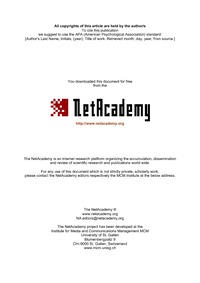 Diese Seite wurde seit 11 Jahren inhaltlich nicht mehr aktualisiert.
Unter Umständen ist sie nicht mehr aktuell.
Diese Seite wurde seit 11 Jahren inhaltlich nicht mehr aktualisiert.
Unter Umständen ist sie nicht mehr aktuell.
 Zusammenfassungen
Zusammenfassungen
 This paper focuses on an aspect which has been neglected, but which is decisive: The transfer of knowledge to different stakeholders; especially the transfer of insights derived from information visualization tools. In knowledge management the transfer of knowledge is a core process, which can be improved by using our innate abilities to process visual representations. The potential of visualizations are manifold. But business managers miss a holistic framework on the use of visualization methods for information exploration and communication tasks. This paper analyzes how architects use visualizations to amplify cognition and to transfer knowledge. It introduces a mediating framework that brings together isolated research directions and defines the new research focus knowledge visualization. Knowledge visualization examines the use of visualizations for the transfer of knowledge between at least two peoples. We found that the new focus is decisive and has implications for researchers in information visualization and knowledge management.
This paper focuses on an aspect which has been neglected, but which is decisive: The transfer of knowledge to different stakeholders; especially the transfer of insights derived from information visualization tools. In knowledge management the transfer of knowledge is a core process, which can be improved by using our innate abilities to process visual representations. The potential of visualizations are manifold. But business managers miss a holistic framework on the use of visualization methods for information exploration and communication tasks. This paper analyzes how architects use visualizations to amplify cognition and to transfer knowledge. It introduces a mediating framework that brings together isolated research directions and defines the new research focus knowledge visualization. Knowledge visualization examines the use of visualizations for the transfer of knowledge between at least two peoples. We found that the new focus is decisive and has implications for researchers in information visualization and knowledge management. This paper defined knowledge visualization and
explained the difference between the research areas
knowledge visualization and information visualization.
In contrast to information visualization, which exploits
our innate abilities to effectively process visual
representation to explore information, knowledge
visualization uses these abilities to improve the transfer
of knowledge between at least two persons or group of
persons. To mediate between different research areas this
paper introduced a knowledge visualization
framework. This framework aims to systemize research,
to identify research gaps and to mediate between
researchers from different fields.
The framework is based on three perspectives: A
Knowledge Type, a Recipient Type and a Visualization
Type Perspective. While the first two taxonomies are
established, the visualization type perspective is new. We
deduced this taxonomy by analyzing how architects use
different complementary visualization types to transfer
knowledge. This taxonomy is promising both for
researchers and practitioners.
This paper defined knowledge visualization and
explained the difference between the research areas
knowledge visualization and information visualization.
In contrast to information visualization, which exploits
our innate abilities to effectively process visual
representation to explore information, knowledge
visualization uses these abilities to improve the transfer
of knowledge between at least two persons or group of
persons. To mediate between different research areas this
paper introduced a knowledge visualization
framework. This framework aims to systemize research,
to identify research gaps and to mediate between
researchers from different fields.
The framework is based on three perspectives: A
Knowledge Type, a Recipient Type and a Visualization
Type Perspective. While the first two taxonomies are
established, the visualization type perspective is new. We
deduced this taxonomy by analyzing how architects use
different complementary visualization types to transfer
knowledge. This taxonomy is promising both for
researchers and practitioners. Dieser Text erwähnt ...
Dieser Text erwähnt ...
 Tagcloud
Tagcloud
 Zitationsgraph
Zitationsgraph
 Zitationsgraph (Beta-Test mit vis.js)
Zitationsgraph (Beta-Test mit vis.js)
 Zeitleiste
Zeitleiste
 5 Erwähnungen
5 Erwähnungen 
- Strategy Visualization - A New Research Focus in Knowledge Visualization and a Case Study (Remo A. Burkhard) (2005)

- Tube Map Visualization - Evaluation of a Novel Knowledge Visualization Application for the Transfer of Knowledge in Long-Term Projects (Remo A. Burkhard, Michael Meier) (2005)

- Knowledge and Information Visualization - Searching for Synergies (Sigmar-Olaf Tergan, Tanja Keller) (2005)
- 13. Towards a Framework and a Model for Knowledge Visualization - Synergies Between Information and Knowledge Visualization (Remo A. Burkhard) (2005)


- 13. Towards a Framework and a Model for Knowledge Visualization - Synergies Between Information and Knowledge Visualization (Remo A. Burkhard) (2005)
- Knowledge Visualization - The use of complementary visual representations for the transfer of knowledge. A model, a framework, and four new approaches (Remo A. Burkhard) (2005)


- Semantic Web - Wege zur vernetzten Wissensgesellschaft (Tassilo Pellegrini, Andreas Blumauer) (2006)
- Knowledge Visualization - Die nächste Herausforderung für Semantic Web Forschende? (Remo A. Burkhard)

- Knowledge Visualization - Die nächste Herausforderung für Semantic Web Forschende? (Remo A. Burkhard)
 Volltext dieses Dokuments
Volltext dieses Dokuments
 |  Learning from Architects: Artikel als Volltext ( Learning from Architects: Artikel als Volltext ( : :  , 249 kByte; , 249 kByte;  : :  Link unterbrochen? Letzte Überprüfung: 2020-11-28 Letzte erfolgreiche Überprüfung: 2014-08-28) Link unterbrochen? Letzte Überprüfung: 2020-11-28 Letzte erfolgreiche Überprüfung: 2014-08-28) |
 Anderswo suchen
Anderswo suchen 
 Beat und dieser Text
Beat und dieser Text
Beat war Co-Leiter des ICT-Kompetenzzentrums TOP während er Dieser Text ins Biblionetz aufgenommen hat. Die bisher letzte Bearbeitung erfolgte während seiner Zeit am Institut für Medien und Schule. Beat besitzt kein physisches, aber ein digitales Exemplar. Eine digitale Version ist auf dem Internet verfügbar (s.o.). Es gibt bisher nur wenige Objekte im Biblionetz, die dieses Werk zitieren.










 Architektur
Architektur Bilder
Bilder Daten
Daten Informationsflut
Informationsflut Visualisierung
Visualisierung Wissen
Wissen










 (
(
 Biblionetz-History
Biblionetz-History